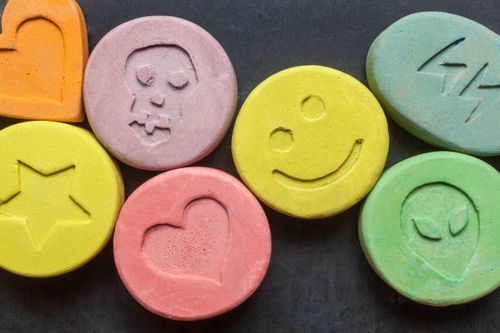Molly: Understanding the Risks
When it comes to Molly, also known as MDMA or Ecstasy, it is important to have a clear understanding of the risks associated with its use. This section will explore Molly's chemical composition and highlight the differences between Molly and pure MDMA.

Molly and Its Chemical Composition
Molly is no longer the pure MDMA it was initially intended to be. Instead, it is often made up of a toxic mix of lab-created chemicals, with the majority of these chemicals originating from laboratories in China. The formulations for synthetic drugs like Molly keep changing, making it challenging for users to know exactly what they are taking. Molly can come in various forms such as capsules, powder, blotting paper (similar to LSD), and even an injectable form, further complicating the identification of its chemical composition.
The use of unknown chemicals in Molly poses a significant danger to users. These synthetic drugs are manufactured with no consideration for their effects on the user, leading to significant batch-to-batch variances and a high risk of death [1]. The constantly evolving chemical compounds used to produce these drugs make it difficult for law enforcement to keep track of them, especially considering that many of the chemicals in Molly are sourced from Chinese laboratories.
Molly vs. Pure MDMA
Originally developed as a therapeutic tool to assist in psychotherapy, MDMA gained popularity as a recreational drug due to its euphoric and empathogenic effects. While Molly is often referred to as MDMA or Ecstasy, it is important to note that there are differences between Molly and pure MDMA.
Pure MDMA refers to the unadulterated form of the drug, containing only the MDMA compound. On the other hand, Molly is a street name commonly used to refer to a substance that is marketed as MDMA but is often mixed with other substances, including unknown chemicals. This mixture poses significant health risks because the user cannot be certain of the exact composition and dosage of the substance they are consuming.
It is crucial for individuals to be aware of the potential dangers associated with Molly and to prioritize their health and safety when making decisions regarding drug use. Understanding the chemical composition of Molly and the distinctions between Molly and pure MDMA can help individuals make informed choices and minimize the risks involved.
Molly Abuse and its Consequences
Molly, also known as MDMA or Ecstasy, is a synthetic psychoactive drug that alters mood and perception, causing heightened feelings of empathy, increased energy, and a sense of well-being. However, it is an illegal substance in most countries due to its potential for abuse and harmful effects on the body.
Molly's Effects on Physical Health
The effects of Molly can vary depending on factors such as individual tolerance, consumed dose, and the presence of other substances. Some common physical effects of Molly include increased heart rate, muscle tension, nausea, blurred vision, and chills or sweating [2].
Moreover, the toxic mix of unknown chemicals in Molly poses a danger to users as the formulations for synthetic drugs keep changing and are manufactured with no consideration for their effects on the user. This leads to significant batch-to-batch variances and a high risk of death.
Mental Impact of Molly Abuse
Prolonged and excessive use of Molly can have long-term psychological and cognitive effects on individuals. Some of these effects may include memory problems, difficulties in concentration and attention, and mood disturbances. In some cases, individuals may experience more severe reactions to Molly, such as panic attacks, hallucinations, and life-threatening conditions like hyperthermia or serotonin syndrome.
Social and Relational Ramifications
The consequences of Molly abuse extend beyond physical and mental health. Molly can have a detrimental impact on an individual's relationships, social life, and overall quality of life. Excessive use of the drug can lead to strained relationships with family, friends, and romantic partners. It may also result in isolation, withdrawal from social activities, and a decline in academic or professional performance. Additionally, the legal consequences of possessing or distributing Molly can have long-lasting effects on an individual's personal and professional life.
Understanding the potential consequences of Molly abuse is crucial for individuals to make informed decisions about drug use. Recognizing the risks associated with Molly and seeking appropriate help and support can help mitigate the negative impact on physical and mental health, relationships, and overall well-being.
The Wesleyan Incident
The Wesleyan incident in which 12 individuals experienced overdoses due to a "bad batch" of Molly sent shockwaves through the campus and raised concerns about the dangers associated with drug use. Understanding the overview of the Wesleyan overdoses and the immediate responses and consequences is crucial in learning from this unfortunate event.
Overview of the Wesleyan Overdoses
On the night of February 21, a widely used club drug known as Molly, which is a form of MDMA, caused 10 students and two guests at Wesleyan University to experience overdoses [3]. The individuals affected by the bad batch of Molly experienced severe health consequences, including unconsciousness and difficulty breathing. Prompt medical attention was required to stabilize their conditions, with one student even receiving over 150 chest compressions, six shocks with a defibrillator, and intubation to save their life [3].
The incident at Wesleyan University caused a significant impact on campus, with ambulances responding multiple times throughout the day to attend to the affected individuals. In total, there were eight similar ambulance runs in response to the drug overdoses.
Immediate Responses and Consequences
Following the Wesleyan incident, swift and decisive actions were taken in response to the drug overdoses. Andrew Olson, a Wesleyan student, was charged in connection with providing the "bad batch" of Molly. Charges against him included possession of marijuana, possession with intent to sell, possession of drug paraphernalia, and possession and sale of hallucinogens.
The incident also led to the arrest of five students on drug-related charges, including the student who almost lost their life and another student who played a pivotal role in reviving them. These arrests highlighted the legal consequences associated with drug abuse and distribution.
The Wesleyan incident served as a wake-up call for the university and the broader community, emphasizing the importance of addressing drug abuse and promoting education and awareness around the risks and consequences associated with Molly and other illicit substances. It sparked conversations about the need for proactive measures to prevent future incidents and ensure the safety and well-being of students and individuals who may be exposed to such dangerous substances.
Molly and the Young Adult Population
Molly, also known as MDMA or ecstasy, has gained popularity among young adults in recent years. Understanding the trends in Molly use among this demographic and the marketing strategies employed can provide valuable insights into the prevalence and impact of this drug.
Trends in Molly Use Among Young Adults
The latest data in 2021 showed that marijuana and hallucinogen use among young adults reached an all-time high, indicating an increase in recreational drug use among this population. While specific statistics on Molly use are not available, it is evident that this drug has become a popular choice among young adults.
Molly is commonly marketed to young first-time drug abusers aged 12 to 17, as well as traditional rave and electronic dance music fans, who may mistake it for MDMA. The accessibility of Molly, combined with its association with music festivals and club scenes, contributes to its appeal among young adults seeking to enhance their recreational experiences.
Molly Marketing and Target Demographics

Molly is marketed to young adults through various channels, including online platforms, music events, and social media. The drug may be portrayed as a party enhancer, promising heightened sensory experiences and a sense of euphoria. The marketing tactics employed often target individuals who are curious or seeking novel experiences.
It is important to note that Molly can come in various forms, such as capsules, powder, blotting paper similar to LSD, and even injectable forms, making it difficult for users to know the exact composition of the substance they are taking. This lack of transparency and standardization poses significant risks to users, as the formulations of synthetic drugs like Molly can vary greatly from batch to batch.
The manufacture and distribution of Molly involve a complex network of chemical laboratories, often located in countries like China, where chemists sell the drugs online [1]. Law enforcement faces challenges in keeping track of the ever-evolving chemical compounds used to produce these drugs, which further contributes to the risks associated with Molly use.
Understanding the trends in Molly use among young adults and the marketing strategies employed is crucial for raising awareness about the potential dangers associated with this drug. By recognizing the target demographics and tactics used to promote Molly, efforts can be made to educate and protect young adults from the potential risks and consequences of its use.
Molly: From Therapeutic Tool to Recreational Drug
The history of MDMA, commonly known as Molly or ecstasy, is a fascinating journey from its initial development as a therapeutic tool to its subsequent recreational use. Understanding this transformation provides valuable insights into the drug's origins and the reasons behind its popularity.
Historical Development of MDMA
German chemists first synthesized MDMA for pharmaceutical purposes in 1912. The substance was discovered to have unique psychoactive properties, leading to the pharmaceutical company Merck patenting MDMA in 1914. However, it took several decades for further drug development to occur [6].
During the Cold War, the U.S. Army and the CIA experimented with MDMA and other hallucinogenic drugs as weapons. The CIA tested MDMA as part of Project MK-Ultra on non-human subjects, which resulted in the first known toxicology studies of MDMA. The drug was given the codename EA-1475.
Evolution of MDMA's Use
In the 1970s, MDMA, known as "Adam" by some psychiatrists, was initially used as a psychotherapeutic tool. It was found to make patients more willing to communicate and participate in the therapy process. However, by the 1980s, MDMA had become more widely known as a party drug and was eventually outlawed in the United States in 1985 under the Controlled Substances Act as a Schedule 1 drug.
Despite being outlawed, some medical researchers have conducted controlled experiments with MDMA, focusing on its potential therapeutic benefits for conditions such as PTSD, depression, anxiety, and other behavioral problems. A 2016 analysis published in the Journal of Psychopharmacology concluded that MDMA "offers a promising treatment for PTSD".
The recreational use of MDMA, often in the form of ecstasy or molly, has gained popularity due to its unique effects. Ecstasy and molly have properties similar to both a stimulant and a hallucinogen. The drug typically induces a sense of euphoria, increased energy levels, heightened arousal, trust, emotional closeness, and empathy with other users. However, it is important to note that the drug can also have negative effects, including spikes in heart rate and blood pressure, increased body temperature, and potentially fatal overheating, especially in hot environments.
Understanding the historical context and evolution of MDMA's use provides valuable insights into the complex nature of this substance. It highlights the various purposes it has served, from its origin as a therapeutic tool to its subsequent recreational use. As with any drug, it is essential to recognize both the potential therapeutic benefits and the associated risks to make informed decisions regarding its use.
Molly: Navigating the Dangers
When it comes to Molly, also known as MDMA or Ecstasy, it is crucial to understand the risks associated with its use. Recognizing and addressing Molly addiction and implementing harm reduction strategies are essential for individuals who engage with this substance.
Recognizing and Addressing Molly Addiction
Molly, as a drug, can have detrimental effects on an individual's physical health, mental well-being, relationships, and overall quality of life. It carries significant risks and potential adverse effects such as panic attacks, hallucinations, life-threatening conditions like hyperthermia or serotonin syndrome, and long-term psychological and cognitive effects [2].
One of the challenges in addressing Molly addiction is the fact that it can come in various forms, such as capsules, powder, blotting paper like LSD, and even an injectable form. This variability makes it difficult for users to know exactly what they are taking. Additionally, the toxic mix of unknown chemicals in Molly poses a danger to users, as the formulations for synthetic drugs keep changing. These drugs are manufactured with no consideration for their effects on the user, leading to significant batch-to-batch variances and a high risk of death [1].
Recognizing the signs of Molly addiction is crucial for early intervention. Some indicators of addiction may include:
- Persistent cravings for Molly
- Neglecting responsibilities and hobbies in favor of Molly use
- Developing tolerance and needing higher doses to achieve the desired effects
- Experiencing withdrawal symptoms when attempting to quit or reduce use
- Continued use despite negative consequences on health, relationships, or work
If you suspect that you or someone you know may have a Molly addiction, it is important to seek professional help. Treatment options may include counseling, support groups, and in severe cases, residential treatment programs. Remember, addiction is a complex condition, and professional assistance is essential for a successful recovery journey.
Harm Reduction Strategies and Resources
Harm reduction strategies aim to minimize the negative consequences associated with drug use. Although the safest approach is to avoid drug use altogether, harm reduction strategies can provide valuable support and education for individuals who choose to use Molly. Some harm reduction strategies include:
- Drug purity testing: Utilizing drug testing services that can provide information about the contents and purity of Molly can help users make more informed decisions.
- Dose moderation: Using Molly in lower doses can help reduce the risk of adverse effects and overdose.
- Hydration and temperature control: Staying hydrated and avoiding overheating is crucial when using Molly, as it can lead to dangerous conditions like hyperthermia.
- Avoiding polydrug use: Combining Molly with other substances can increase the risks and potential harm. It is important to avoid mixing drugs.
- Open communication and support: Encouraging open dialogue about drug use, providing non-judgmental support, and informing individuals about available resources can make a positive impact.
Numerous organizations and resources are available to provide education, support, and harm reduction information for individuals using Molly. Some examples include:
- The Multidisciplinary Association for Psychedelic Studies (MAPS): A nonprofit research and educational organization dedicated to exploring the potential benefits of psychedelic substances.
- DanceSafe: An organization that promotes health and safety within the nightlife and electronic music communities, providing harm reduction resources and drug checking services.
- National Institute on Drug Abuse (NIDA): A government organization that offers research-based information on drug use, addiction, and treatment.
By recognizing the signs of Molly addiction and implementing harm reduction strategies, individuals can navigate the potential dangers associated with this substance and strive for a healthier and safer relationship with drugs.
References
- [1]: https://www.cnn.com
- [2]: https://www.doverecovery.com
- [3]: https://www.nytimes.com
- [4]: https://www.fox61.com
- [5]: https://nida.nih.gov
- [6]: https://www.history.com
-
Related MDMA & Ecstasy Articles
- What Is Ecstasy Made From? — Explore how ecstasy (MDMA) is synthesized, what street pills may actually contain, and why purity is unpredictable.
- Blue Dolphin MDMA: The Hidden Dangers of This Ecstasy Pill — A detailed look at a specific illicit ecstasy pill brand, its risks, adulterants, and overdose potential.
- Molly: What We Can Learn from the Wesleyan 12 — Examines a real incident of Molly use, the risks of adulteration and how that informs safe-use & treatment conversations.
- What Are Party Drugs? — Broad overview of “party drugs” including MDMA, how they're used socially, and what the risks and trends are.
- Substance Abuse Treatment - If you or someone close to you is struggling with addiction to these substances we are here to help.
At Prescott House, Recovery Becomes Reality
MDMA and Ecstasy use can quickly spiral from experimentation into dependence, anxiety, relationship problems, and dangerous patterns of substance misuse. At Prescott House in Prescott, Arizona, we help men rebuild their lives through long-term, evidence-based treatment that addresses both substance use and co-occurring mental health issues.
Explore Our Specialized Programs:
- Long-Term Addiction Treatment for Men — Structured healing, accountability, and extended care designed for lasting recovery.
- Substance Abuse Treatment — Comprehensive care for alcohol and drug dependence, including stimulant and club-drug misuse.
- Gambling Addiction Treatment — Support for men struggling with compulsive gambling and related behaviors.
- Sex & Process Addiction Programs — Compassionate treatment for compulsive behaviors, sexual addiction, and pornography addiction.
- Dual Diagnosis Treatment — Integrated care for co-occurring mental health and substance use disorders.
👉 Learn more about our programs →













